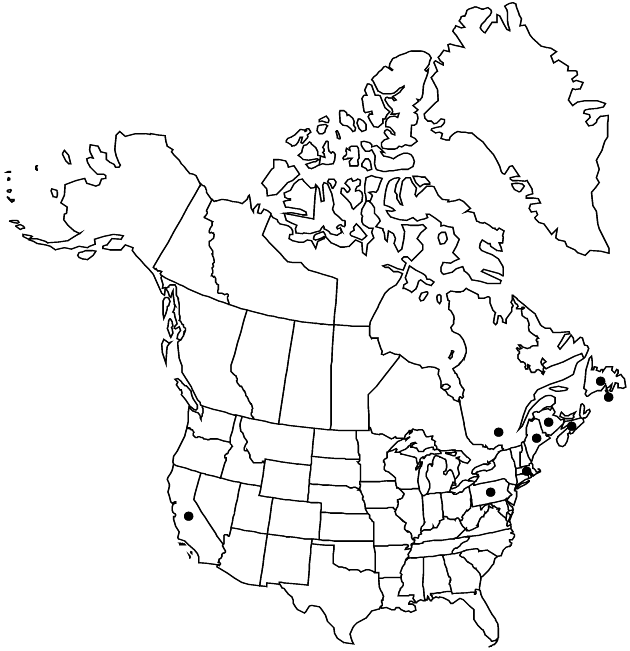Difference between revisions of "Tripleurospermum maritimum subsp. maritimum"
FNA>Volume Importer |
imported>Volume Importer |
||
| (2 intermediate revisions by 2 users not shown) | |||
| Line 20: | Line 20: | ||
|elevation=0–10 m | |elevation=0–10 m | ||
|distribution=St. Pierre and Miquelon;N.B.;Nfld. and Labr. (Nfld.);N.S.;Que.;Calif.;Maine;Mass.;Pa.;Europe. | |distribution=St. Pierre and Miquelon;N.B.;Nfld. and Labr. (Nfld.);N.S.;Que.;Calif.;Maine;Mass.;Pa.;Europe. | ||
| + | |introduced=true | ||
|discussion=<p>Specimens examined from inland North America that had been attributed to <i>Tripleurospermum maritimum </i>subsp.<i> maritimum</i> were all <i>T. inodorum</i>. The identity of the plant called <i>T. maritimum</i> in St. Pierre and Miquelon is uncertain; I did not have access to the voucher specimens and some plants so labeled in maritime eastern Canada were in fact <i>T. inodorum</i>. I am uncertain as to whether or not this taxon persists in northeastern North America. Some specimens identified to this taxon, even on the coast, may be <i>T. inodorum</i> individuals that have become multi-stemmed through damage or via other mechanisms, particularly on sand dunes. Such specimens are difficult to classify as annual or perennial if the taproot is not dug out, and the lack of cypselae may prevent positive identification.</p> | |discussion=<p>Specimens examined from inland North America that had been attributed to <i>Tripleurospermum maritimum </i>subsp.<i> maritimum</i> were all <i>T. inodorum</i>. The identity of the plant called <i>T. maritimum</i> in St. Pierre and Miquelon is uncertain; I did not have access to the voucher specimens and some plants so labeled in maritime eastern Canada were in fact <i>T. inodorum</i>. I am uncertain as to whether or not this taxon persists in northeastern North America. Some specimens identified to this taxon, even on the coast, may be <i>T. inodorum</i> individuals that have become multi-stemmed through damage or via other mechanisms, particularly on sand dunes. Such specimens are difficult to classify as annual or perennial if the taproot is not dug out, and the lack of cypselae may prevent positive identification.</p> | ||
|tables= | |tables= | ||
| Line 44: | Line 45: | ||
|publication year= | |publication year= | ||
|special status= | |special status= | ||
| − | |source xml=https:// | + | |source xml=https://bitbucket.org/aafc-mbb/fna-data-curation/src/2e0870ddd59836b60bcf96646a41e87ea5a5943a/coarse_grained_fna_xml/V19-20-21/V19_958.xml |
|tribe=Asteraceae tribe Anthemideae | |tribe=Asteraceae tribe Anthemideae | ||
|genus=Tripleurospermum | |genus=Tripleurospermum | ||
Latest revision as of 19:57, 5 November 2020
Phyllaries oblong or narrowly triangular, scarious margins pale to dark brown, 0.2–0.4 mm wide. Cypselae: resin gland lengths often much more than twice widths. 2n = 18, 36.
Phenology: Flowering Jun–Sep.
Habitat: Roadsides, fields, waste places
Elevation: 0–10 m
Distribution

Introduced; St. Pierre and Miquelon, N.B., Nfld. and Labr. (Nfld.), N.S., Que., Calif., Maine, Mass., Pa., Europe.
Discussion
Specimens examined from inland North America that had been attributed to Tripleurospermum maritimum subsp. maritimum were all T. inodorum. The identity of the plant called T. maritimum in St. Pierre and Miquelon is uncertain; I did not have access to the voucher specimens and some plants so labeled in maritime eastern Canada were in fact T. inodorum. I am uncertain as to whether or not this taxon persists in northeastern North America. Some specimens identified to this taxon, even on the coast, may be T. inodorum individuals that have become multi-stemmed through damage or via other mechanisms, particularly on sand dunes. Such specimens are difficult to classify as annual or perennial if the taproot is not dug out, and the lack of cypselae may prevent positive identification.
Selected References
None.